
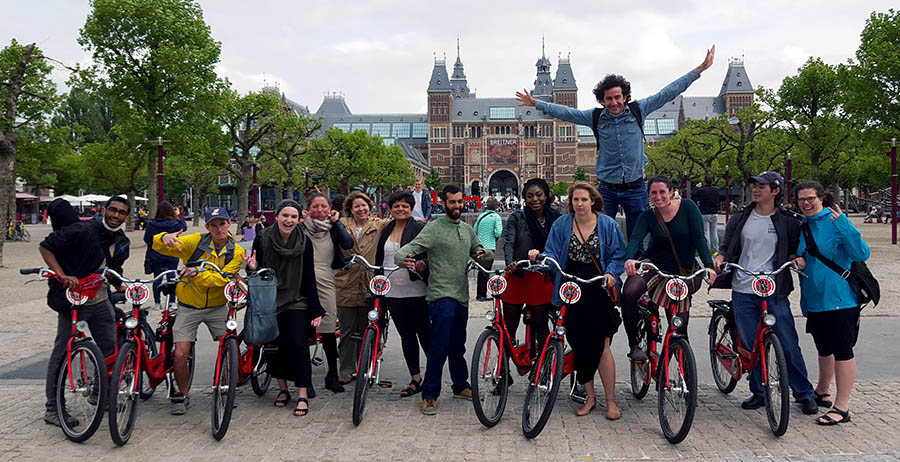 The Sustainable Transportation Abroad class spent nearly two weeks traveling throughout the Netherlands — mostly by bicycle — studying the country's transportation systems, including how infrastructure is designed to give cyclists priority, the integration of public transit and biking infrastructure, and suburban transportation design. The trip included seven students, two teaching assistants, Assistant Professor Kari Watkins, and three transportation professionals from the City of Atlanta and the Georgia Department of Transportation. (Photo: Sustainable Transportation Abroad class) |
A group of Georgia Tech students has just returned from two weeks studying bicycle infrastructure in the Netherlands and contrasting the Dutch approach to American standards.
The overwhelming consensus: it’s not just bicycles that define the Dutch transportation system. Rather, it's the integration of biking with all forms of public transit and infrastructure planning that makes the Netherlands’ famed bike culture a way of life.
“The Dutch designs are completely driven by their efficiency-seeking culture. They are environmentally aware and health conscious, and their policies on cycling reflect those ideals,” senior Matthew Miller wrote on the class’s blog.
“In order for Dutch designs to work in America, there must be a shift in attitude toward [transportation] modes beyond cars,” he noted.
“My hope is that we can bring back the designs we witnessed firsthand abroad and make the first steps in redefining Atlanta’s system by implementing some of these principles,” wrote fellow senior Savannah Brooks.
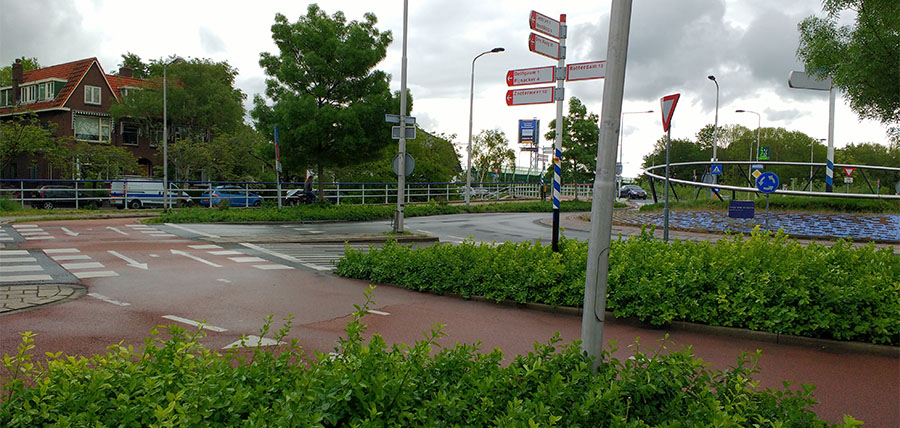 |
| Above: A roundabout design common in the Netherlands where bicycle and automobile traffic is separated. Vehicles travel in the centermost lanes and bicycles use the outer, red-colored lanes. Striping instructs car drivers to yield to bike traffic as they enter the roundabout. (Photo: Alice Grossman) Right: A Delft-area street with on-road parking, dedicated red bicycle lanes, and a single lane for vehicle traffic. Pedestrian crosswalks are raised to help slow traffic. (Photo: Sustainable Transportation Abroad class) | 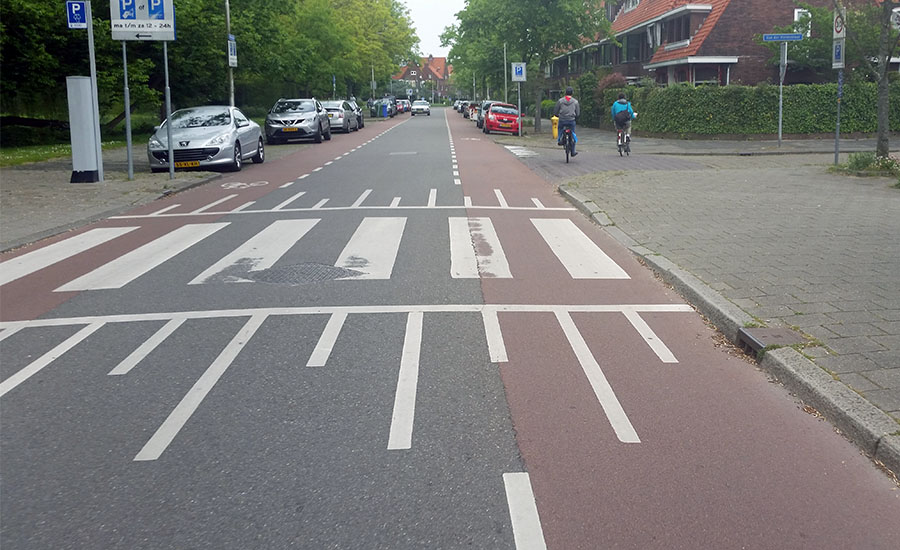 |
The trip was part of a new class in the School of Civil and Environmental Engineering called Sustainable Transportation Abroad designed and taught by Kari Watkins. It’s one of two new study-abroad courses rolling out this summer spurred by the School’s Global Engineering Leadership minor.
The course incorporated modules on mentoring, and students interacted with three Atlanta-area transportation professionals who traveled with them to Europe. That part of the course was made possible by civil engineering alumnus Mike Messner and his wife, Jenny, whose donation allowed Faye DiMassimo, general manager of the City of Atlanta Renew Atlanta Infrastructure Program, and Hiral Patel, the director of engineering for the Georgia Department of Transportation, to go on the trip.
The City of Atlanta chipped in so Becky Katz, the city’s chief bicycle officer, could go along, too.
“Because this trip incorporated so many professionals with great insight both from abroad and Atlanta, I feel this trip has firmly cemented my desire to become a transportation engineer,” Lauren Gardner wrote shortly after the trip. “I could not see myself doing anything else.”
“I feel empowered to be not just a civil engineer, but a global leader.”
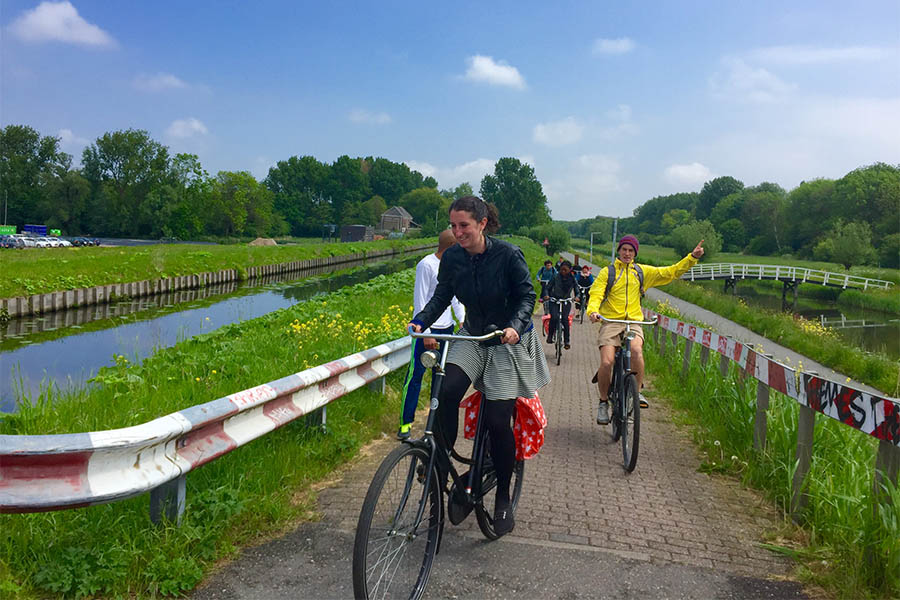 Teaching assistant Alice Grossman leads a group of School of Civil and Environmental Engineering students along a bike trail in the suburban area of Leidschenveen-Ypenburg. (Photo: Sustainable Transportation Abroad class) |
As part of the course, students kept a blog about their experiences and what they were learning. Here’s more of what they wrote:
On giving bicycles priority over cars:
The Dutch separate cyclists from vehicular traffic while the U.S. merges the two. The effects of this difference on comfort levels and overall ride enjoyment makes cycling in the Netherlands simply a matter of practicality. Why would you not use bikes as your primary mode of transportation when the infrastructure makes it so safe and easy? – Savannah Brooks
The first few times you approach an intersection between car traffic and bike traffic, you naturally slow down and attempt to wait for the car to pass. Then you realize they are actually waiting on you to go first. But as you become accustomed to being yielded to, you begin to notice the practicality of designing your transportation system to accommodate the more vulnerable modes. For example, it takes considerably more effort to stop and go on a bike as compared to a car. – Matthew Miller
I’m still having an infraculture shock. I’ve been a pedestrian and a cyclist, and a user of transport, in two different cities in the Netherlands. What amazes me is the effort that has been put in to prioritize cyclists here. … Cycling here is like breathing. Anyone can do it at anytime and anywhere. – Ambar Johnson
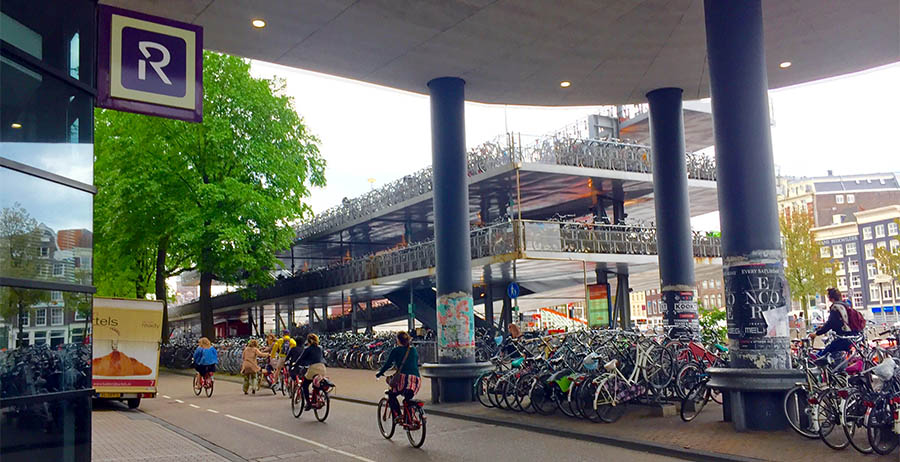 |
|
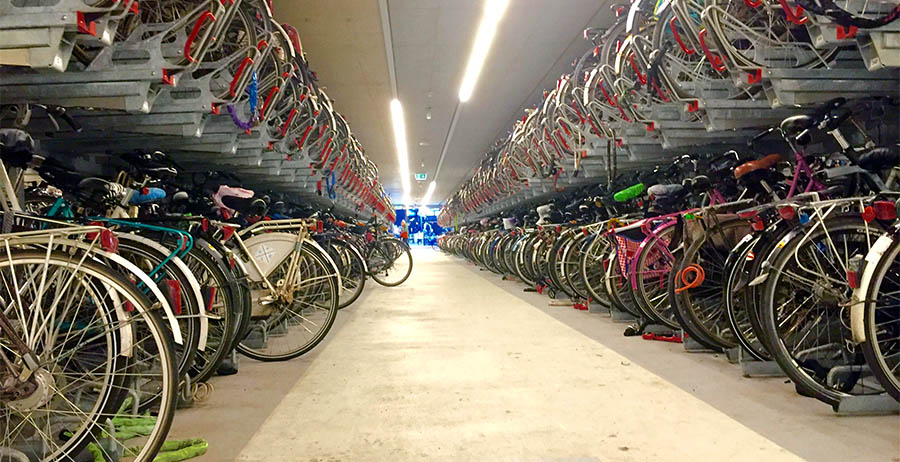 |
|
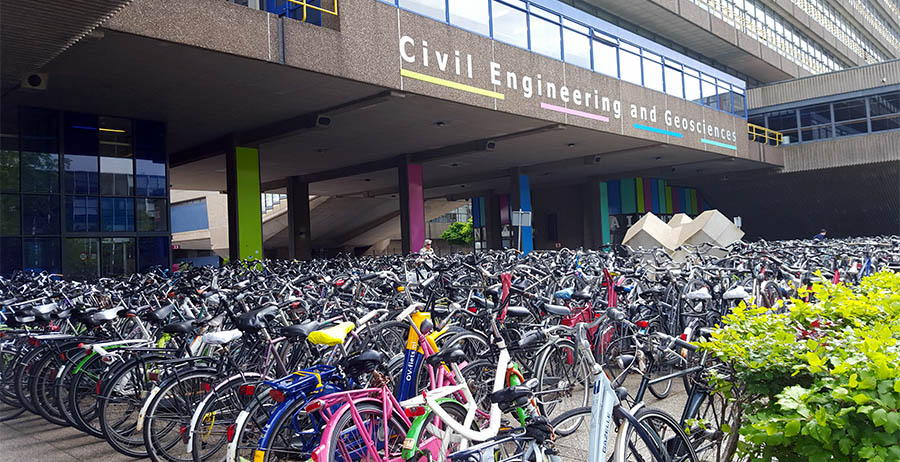 Above top: Multistory bicycle parking at a transit station in Amsterdam. Above middle: An example of the double-decker bike storage common in transit stations around the Netherlands. Above bottom: Bicycle parking outside the civil engineering and geosciences building at the Delft University of Technology. (Photos: Sustainable Transportation Abroad class) |
|
On integrating bicycle infrastructure with public transit:
Before coming to the Netherlands I was under the impression that it was the bicycle that made Dutch transportation work so efficiently. In reality, it is the combination of the bicycle with the public transit system that makes transportation in the Netherlands so easy. – Sam Dennard
The train stations are designed so that cyclists can ride directly to parking areas in close proximity of the station entrance. Some stations, such as Delft, have extensive covered parking that is even easier to access than walking to the station. No station ever requires cyclists to carry their bike up/down a flight of stairs. There is always direct access. This system is very convenient and efficient for transitioning transportation modes. – Matthew Miller
The Dutch make the integration of bicycle, train, tram, plane, and boat seem extremely doable anywhere in the world with the proper atmosphere and willpower. – Lauren Gardner
On Dutch culture’s influence in the country’s transportation network:
The Dutch like to plan everything and be as simplistic with their designs as possible. This is a part of their culture and European nature in general and this was something that was really apparent during our visit. Most people were direct and to the point, they were extremely punctual, and they liked getting straight to business. … This behavior might seem rude to some people in America, but I believe that is the exact reason why it is so important to be culturally aware and to respect the traditions and practices of different cultures. The behavioral practices translated in their infrastructure design as it was meant to be safe, fast and easy. – Noor-ur-Rahman Shaikh
As the Dutch have allowed their culture to shape their design, their designs have also shaped their culture. Over the course of two weeks, we were able to notice that because they have such high efficiency overall during the workweek, their shops tend to close at six o’clock and that evenings remain a time for friends and family. When you think about how many things one could do with the accrued time waiting in traffic in America, perhaps a similar culture could ensue. Perhaps, not only would physical health be benefited from the Dutch designs, but also emotional health as well. – Lauren Gardner

